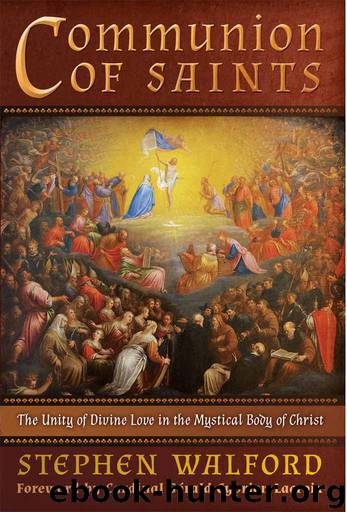Communion of Saints: The Unity of Divine Love in the Mystical Body of Christ by Stephen Walford & Cardinal Gerald Lacroix

Author:Stephen Walford & Cardinal Gerald Lacroix
Language: eng
Format: mobi
Publisher: Angelico Press
Published: 2016-10-18T16:00:00+00:00
* * *
1. Pope Benedict XVI, Apostolic Letter declaring St. Hildegard of Bingen a Doctor of the Church, October 7, 2012, www.vatican.va.
2. Hildegard of Bingen, The Book of the Rewards of Life (Liber vitae meritorum) (New York: Oxford University Press, 1994), 47.
3. As with many of St. Hildegard’s visions, there is a rich symbolism reminiscent of the Old Testament prophets. Pope Benedict XVI points this out in the Apostolic Letter of October 7, 2012: “Hildegard’s language, characterized by an original and effective style, makes ample use of poetic expressions and is rich in symbols, dazzling intuitions, incisive comparisons and evocative metaphors.” In a Letter to Saint Bernard, the Rhenish mystic reveals something of her extraordinary charism: “Father, I am greatly disturbed by a vision which has appeared to me through divine revelation, a vision seen not with my fleshly eyes but only in my spirit . . . Through this vision which touches my heart and soul like a burning flame, teaching me profundities of meaning, I have an inward understanding of the Psalter, the Gospels, and other volumes.” The Letters of Hildegard of Bingen: vol. 1, trans. Joseph L. Baird and Radd K. Ehrman (New York: Oxford University Press, 1994), 27-28. 1994), 27-28.
4. Hildegard of Bingen, The Book of Divine Works (Santa Fe: Bear &Company, 1987), 155.
5. Ibid., 160.
6. Ibid., 161.
7. In the Causae et Curae, Book One, St. Hildegard writes: “O man, look to man. For man has the heavens and earth and other created things within him. He is one, and all things are hidden within him.” Hildergardis, Causae et curae, (Leipzig: In aedibus B.G. Teubneri, 1903), 2.
8. Ibid., 233.
9. In Scivias, Hildegard explains that straw refers to those who negate and reject the Catholic faith.
10. Hildegard of Bingen, The Personal Correspondence of Hildegard of Bingen, ed. Joseph L. Baird (New York: Oxford University Press, 2006), 126–127.
11. St. Hildegard of Bingen, Liber vitae meritorum, III, 2–3.
12. Pope Benedict XVI, Apostolic Letter Proclaiming St. Hildegard a Doctor of the Church, October 7, 2012, www.vatican.va.
13. Pope Francis, “Message to The Bishop of Avila on the occasion of the opening of The Teresian Jubilee Year,” October 15, 2014, www.vatican.va.
14. St. Teresa of Avila, Collected Works, vol. 1: The Book of Her Life, Spiritual Testimonies, Soliloquies (Washington DC: ICS Publications, 1976), 200–201.
15. Of particular note in St. Teresa’s writings is the power and influence of St. Joseph: “It is an amazing thing the great many favors God has granted me through the mediation of this blessed saint, the dangers I was freed from both of body and soul. For with other saints it seems the Lord has given them grace to be of help in one need, whereas with this glorious saint I have experience that he helps in all our needs and that the Lord wants us to understand that just as He was subject to St. Joseph on earth—for since bearing the title of father, being the Lord’s tutor Joseph could give the Child command—so in heaven God does whatever he commands.
Download
This site does not store any files on its server. We only index and link to content provided by other sites. Please contact the content providers to delete copyright contents if any and email us, we'll remove relevant links or contents immediately.
Resisting Happiness by Matthew Kelly(3200)
The Social Psychology of Inequality by Unknown(2773)
Designing Your Life by Bill Burnett(2606)
Day by Elie Wiesel(2599)
The Giving Tree by Shel Silverstein(2178)
Angels of God: The Bible, the Church and the Heavenly Hosts by Mike Aquilina(1871)
Human Design by Chetan Parkyn(1859)
The Supreme Gift by Paulo Coelho(1802)
Jesus of Nazareth by Joseph Ratzinger(1710)
Augustine: Conversions to Confessions by Robin Lane Fox(1688)
Hostage to the Devil by Malachi Martin(1676)
7 Secrets of Divine Mercy by Vinny Flynn(1623)
Dark Mysteries of the Vatican by H. Paul Jeffers(1607)
The Vatican Pimpernel by Brian Fleming(1589)
St. Thomas Aquinas by G. K. Chesterton(1559)
Saints & Angels by Doreen Virtue(1532)
The Ratline by Philippe Sands(1426)
My Daily Catholic Bible, NABRE by Thigpen Edited by Dr. Paul(1418)
Called to Life by Jacques Philippe(1411)
